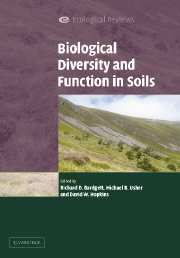Book contents
- Frontmatter
- Contents
- List of contributors
- Preface
- Acknowledgements
- PART I Introduction
- PART II The soil environment
- PART III Patterns and drivers of soil biodiversity
- 5 The use of model Pseudomonas fluorescens populations to study the causes and consequences of microbial diversity
- 6 Patterns and determinants of soil biological diversity
- 7 How plant communities influence decomposer communities
- 8 The balance between productivity and food web structure in soil ecosystems
- 9 Rhizosphere carbon flow: a driver of soil microbial diversity?
- PART IV Consequences of soil biodiversity
- PART V Applications of soil biodiversity
- PART VI Conclusion
- Index
- References
9 - Rhizosphere carbon flow: a driver of soil microbial diversity?
Published online by Cambridge University Press: 17 September 2009
- Frontmatter
- Contents
- List of contributors
- Preface
- Acknowledgements
- PART I Introduction
- PART II The soil environment
- PART III Patterns and drivers of soil biodiversity
- 5 The use of model Pseudomonas fluorescens populations to study the causes and consequences of microbial diversity
- 6 Patterns and determinants of soil biological diversity
- 7 How plant communities influence decomposer communities
- 8 The balance between productivity and food web structure in soil ecosystems
- 9 Rhizosphere carbon flow: a driver of soil microbial diversity?
- PART IV Consequences of soil biodiversity
- PART V Applications of soil biodiversity
- PART VI Conclusion
- Index
- References
Summary
SUMMARY
Microorganisms play an essential role in modulating the fluxes of organic carbon and nutrients in soil. However, their diversity and functional significance are largely unknown. Recent technical developments in molecular, chemotaxonomic and physiological techniques complement traditional techniques and can now enable us to investigate the linkage between rhizosphere carbon flow, microbial diversity and soil function.
Reporter gene systems provide an important method for resolution of rhizosphere carbon flow. Their greatest advantage is that they can be used in situ without uncoupling the plant–microbial interaction vital to maintaining both quantity and quality of carbon flow.
Any consideration of rhizosphere carbon flow and soil microbial diversity should not only include substrate carbon flow and trophic interactions, but also the role of signal molecules, especially in terms of controlling rhizosphere community structure, diversity and function.
Little is known of carbon flow in natural systems. Ecosystem function and, specifically, carbon-cycling pathways can be determined by lipid analysis or nucleic acid stable isotope probing (SIP) using 13C incorporated into microbial biomass. The ability to ascertain which components of the biomass are being enriched in root-derived carbon enables an understanding of how rhizosphere carbon drives microbial diversity.
Changes in 16S rDNA sequence diversity and relative abundance provide indications of which organisms are responding to changing conditions and SIP analysis of mRNA allows for assessment of their activity, and thus may be used to follow changes in the microbial community during rhizosphere development.
- Type
- Chapter
- Information
- Biological Diversity and Function in Soils , pp. 154 - 168Publisher: Cambridge University PressPrint publication year: 2005
References
- 3
- Cited by



